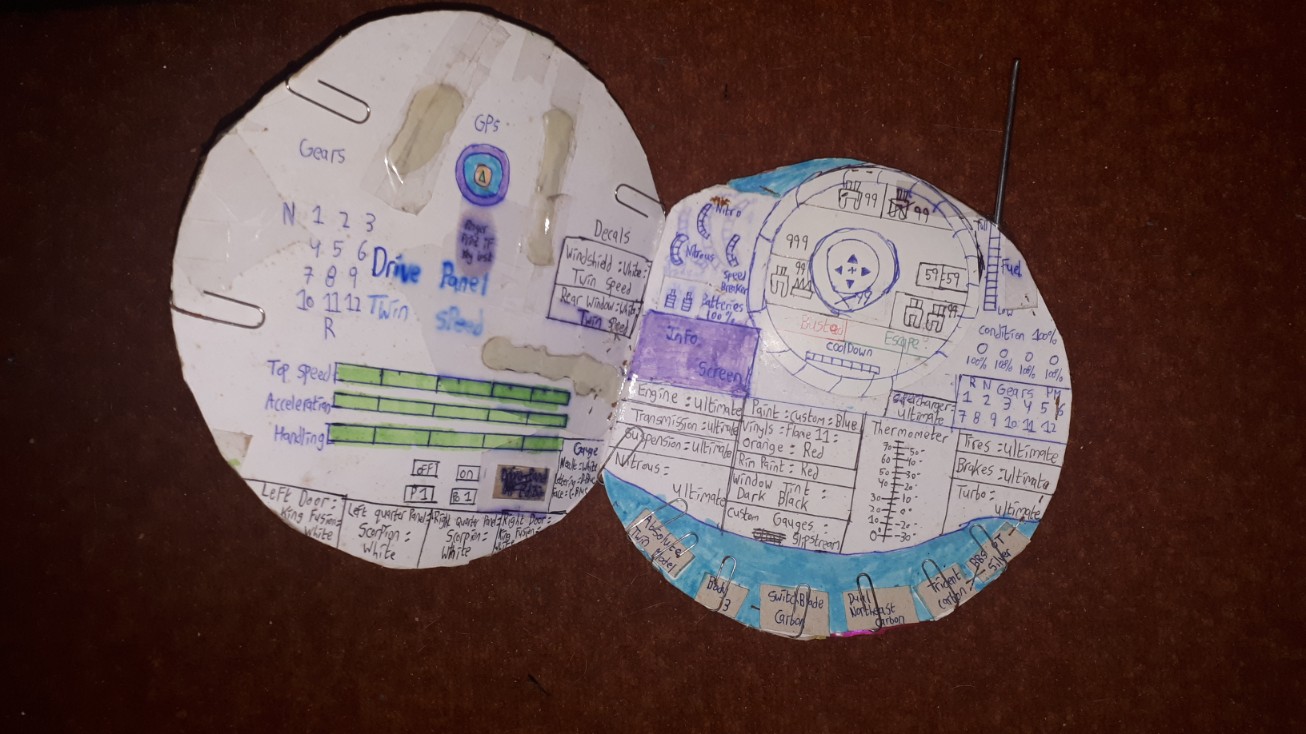Drive Panels
I absolutely loved car racing video games. My father had a PC and I usually played Need for Speed - Most Wanted (the 2005 version) on it. Needless to say, I was a big car fan. Weeks after, me and my cousins started making epic Drive Panels. Read more below!





Debuts
One morning, I was sitting in my living room and didn’t have much to do. Looking
outside, I saw my 2 youngest cousins running with a round cardboard piece in their hands and they were
imitating car sounds. Some minutes later, I went to their house. Apparently they got hold of some round
cardboard pieces and pretended that they were steering wheels. I loved the idea and wanted to have mine too.
I went home and with the help of a pencil, a big bowl and a pair of scissors, I made my own cardboard
steering wheel.
My cousin added some more things to their cardboard steering wheels. They made 2 round circles and added
readings on them. They then pinned a little cardboard arrow to the middle of each of these circles. Behind
the cardboard steering wheels, these pins were fixed to a piece of cork. The piece of cork could be rotated
to simulate the movement of the arrows. Basically, these circles and arrows were used as speedometers and
revolution gauges. Eventually, I added these to my cardboard steering wheels too. Some while after, I
came up with the “Drive Panel” name for our cardboard steering wheels and I made up most of the following
additions to our drive panels.
More features
Usually watercolour tubes could be found behind drive panels which were assumed
to be fuel/oil tanks. There were usually long wooden sticks or metal rods which served as the car antenna.
Robot feet and arms could spring from our imaginary cars, we could toggle and change the intensity of our
car lights and even sweep the window glasses when it was raining. There was also the turn signals and of course,
dear precious nitrous. Nitro and Nitrous were basically the same thing and you’ll know what’s ‘speedbrake’
if you’ve played the original Need For Speed Most Wanted. The ‘overheat’ meter was inspired from games
such as Offroad Racers which provide unlimited nitrous but causes the car to blow up if used continuously
for too long. The paperclips on top each served two purposes; if pushed up, this cause a change of gears
and if pushed down, toggles the turn lights. Keys had a variety of methods to be inserted, ranging from
holes to ‘pockets’. Cars could be used with manual or automatic gears though and even had AC options.
Other basic features included a radio, a music player and attack/defense protocols. 2 pieces of cotton
were stuck to drive panels and were used as the acceleration and brake pedals.
There were a lot of drive panels that were made. Some great, some less great. The last one I made was
the “Twin Speed” edition and was actually named like that since it could be opened and hence had 2 screens
(see the second picture). On the back of the first screen, the performance of the car in 3 fields (top speed,
acceleration, handling) was listed along with the number of gears that it had. Decorations (decals & vinyls)
could be placed on parts of the car and the authenticity of the owner (me) could be verified using fingerprints.
On the second screen or panel, there was a big radar to detect cops and to display information about the amount
of damage that my vehicle had caused. Then, there were some indicators on the amount of nitro, nitrous,
speedbreaker and fuel left along with indications on the states of several important components of the car
(batteries, wheels). There was also a screen to display various stuff, a thermometer and a quicker way of
changing gears. On the bottom half of the second panel, there was yet more customisation and upgrade options
for the car, again based on Need for Speed Most Wanted. Concerning the paperclips on the bottom, parts of the
car or the car itself (vehicle type/model, body kit, spoilers, roof scoops, hood, rims) could be replaced
by another vehicle or by other parts by means of little cardboard chips.
Related stuff
As you may already know, personalized drive panels could be bought and customised from Kishan’s Shop. Also, several complementary inventions were made to go along with drive panels. First, cardboard chips were made so that vehicles or their components could be modified as you read about above. Then, there was the drive panel guide which was essentially a copybook detailing everything that was ever featured on a drive panel. It also contained the name of decals, vinyls and other custom vehicle components along with a list of every drive panel I made and their ratings. Lastly, there was a map that was made for me and my cousins to use while playing with our drive panels. We would imagine that we were in our vehicle which was usually a car, and we’d drive using our drive panel. Additionally, there were small unique cardboard chips that each corresponded to a player. We would then move our chip to point where we were on that map. These player chips had 2 ways of being connected to our drive panel; either in a wired way or wirelessly. If the former option was chosen, a wire, literally from a broken earphone cable was used else, a nail was inserted on the map which acted as a wireless dongle (provided that the drive panel had these wireless abilities). Basically, that was everything about drive panels and the last section of my childhood highlights!